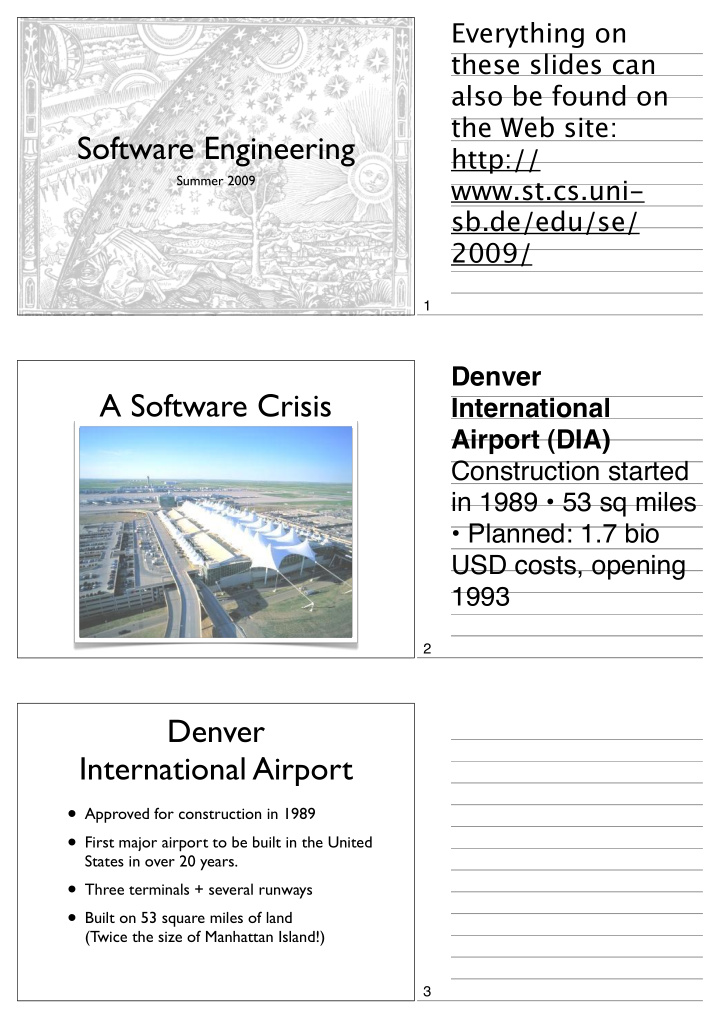



Everything on these slides can also be found on the Web site: Software Engineering http:// Summer 2009 www.st.cs.uni- sb.de/edu/se/ 2009/ 1 Denver A Software Crisis International Airport (DIA) Construction started in 1989 • 53 sq miles • Planned: 1.7 bio USD costs, opening 1993 2 Denver International Airport • Approved for construction in 1989 • First major airport to be built in the United States in over 20 years. • Three terminals + several runways • Built on 53 square miles of land (Twice the size of Manhattan Island!) 3
BAE Contract • Original assumption: Every company builds its own baggage transport system • United (70% Denver traffic) was the only to begin planning; contract with BAE • First fully automated baggage system • Later, Denver airport extended contract to entire airport – three times original size 4 The Scope • 20 miles of track • 6 miles of conveyor belts • 56 laser arrays that read bar coded tags • 400 frequency readers • 3,100 standard size baggage ‘Telecars’ • 450 6.5 ft by 4 ft oversize cars • 55 separate computers 5 The System 6
The System 7 The System 8 The Timeframe • BAE started work 17 months before scheduled opening October 31, 2003 • In Munich (similar system), engineers had spent two years just testing the system (with 24/7 operation six months before the airport opened) 9
More Risks • Most of buildings were already done, so BAE had to accommodate system (sharp turns, narrow corridors…) • BAE paid little attention to German sister project and devised system from scratch • Little communication within BAE 10 While all of the Final Blunder previous blunders contributed to the failure of the system, the worst • The decision to broadcast the preliminary mistake was still test of the “revolutionary” new baggage system on national television yet to come. It was a decision so terrible, so foolish, 11 so absolutely What camera crews depicted was truly a disaster; carts jammed together, damaged luggage everywhere, some bags literally split in half, and the tattered remains of 12 clothing strewn
A Disaster • Carts jammed together • Damaged luggage everywhere, some bags literally split in half • Tattered remains of clothing strewn about caused subsequent carts to derail • Half the luggage that survived the ordeal ended up at the wrong terminal 13 More Issues • Carts got stuck in narrow corridors • Wind blew light baggage from carts • 5% of the labels were read correctly • Normal network load was 95% 14 Complexity: Empty Carts • Empty carts need to go where they are needed • Cart has to be at its “cannon” at the right moment • Lanes have limited length ➔ traffic jam • All controlled by single central system 15
Consequences • Airport opening delayed four times – overall, sixteen months late • New engineering firm • split system in three (one per terminal) • implemented manual backup system • BAE got bankrupt • Overall damage: 1.3 bln USD 16 This and other laws Glass’ Law are found in Endres/Rombach: Handbook of Software and Requirement deficiencies Systems are the prime source of project failures. Engineering. Evidence: Denver airport case study 17 and two more http:// Chaos Report www.standishgrou p.com • 31% of projects were aborted prior to completion • in small (large) development companies, only 16% (9%) of all projects were completed within projected budget and time limits Survey by the Standish Group, 1994 – 350 companies with >8000 software projects 18
16% of all projects successful Project Success 53% operational, but less than successful successful operational cancelled 31% cancelled 16% 31% 53% Survey by PC week, 1995: 365 information systems professionals on success of software development projects 19 Airbags: RISKS 20.28, March 29, 1999: a baby More Examples sitting in a rear facing car seat mounted to the front seat Toll Collect Airbus A 380 in a Volkswagen Golf was (2003) (2006) killed by the impact of the deploying air bag in an AT&T outage oncoming traffic Airbags (1999) (1990) collision. The car owners and parents of the killed baby had previously had 20 21
Challenges • Why does it take so long to get software finished? • Why are the development costs so high? • Why can’t we find all errors? • Why do we spend so much time and effort maintaining existing programs? • Why is it difficult to measure progress? 22 Topics • Requirements Engineering • Software Specification • Software Design and Architecture • Advanced Programming Techniques • Software Quality Assurance • Software Maintenance and Evolution • Software Project Management 23 Your Lecturers • Andreas Zeller • Frank Padberg • Some Guests • Lecture Tue+Thu 8:30–10:00 HS2 24
Your Tutors • Kim Herzig (coordinator) • Yulya Patenko • David Nemer 25 KIM HERZIG 26 Exercise Dates 27
Exercise Sheets • Every Thursday morning • To be completed until next Thursday • Discussed in exercise groups 28 Mini Tests • Every Thursday morning at 08:30 • 10-minute questionnaire about last week’s exercise sheet • Be there on time! 29 Your Grades • Log on to the Web site to see your grades • You get a password by the end of this week 30
Schedule 31 Schedule 32 Books 33
Exams • Final Exam end of term (last week of July) • Extra Exam beginning of term (October) • Requirement: 50% of mini tests grades 34 Grading Exam Mini tests 90% 10% 35 Web Site 36
Sign up! 37 Summary 38
Recommend
More recommend